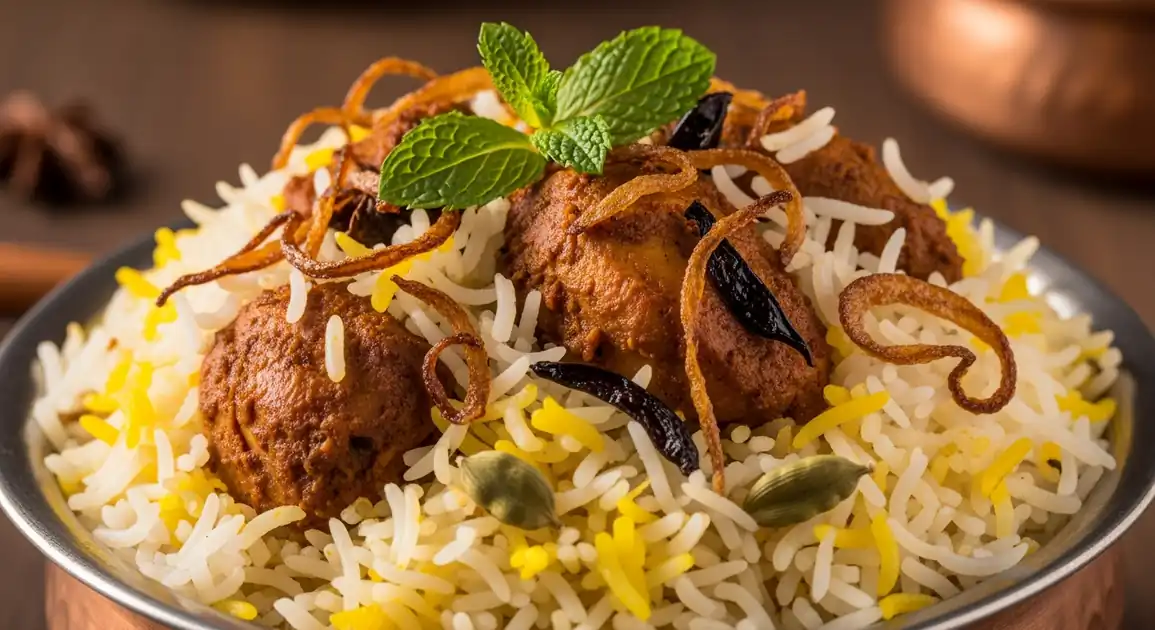Biryani
बिरयानी

Description
Delhi, with its rich Mughlai heritage, offers a fantastic Biryani experience. While not having one single 'Delhi style' like Hyderabad or Lucknow, the city boasts numerous eateries serving excellent, often robustly flavored Mutton and Chicken Biryani, particularly concentrated in areas like Old Delhi (Jama Masjid, Chandni Chowk) and Nizamuddin.
Dietary Information
Serving information
Serving style
Typically served on a plate, sometimes directly from a large 'degh' (pot). Usually accompanied by mint raita and sliced onions. Some places might offer a side of Korma gravy.
Quick facts
Old Delhi: Many places open from lunch (around 12 PM) till late night (1 AM or later). Nizamuddin: Mainly evenings (6 PM onwards). Restaurants elsewhere: Standard lunch (12 PM - 3 PM) and dinner (7 PM - 11:30 PM) timings.
Safety Tips
What to Look For
-
Served steaming hot
Heat is crucial for both taste and safety, especially for rice dishes. Ensure the Biryani is served directly from a hot pot, releasing steam.
-
Busy vendor with high turnover
Indicates the Biryani is freshly made and hasn't been sitting at unsafe temperatures for long.
-
Separate, fluffy rice grains
Properly cooked Biryani shouldn't be mushy or clumped, indicating good quality rice and cooking technique. This also indirectly relates to freshness.
-
Pleasant, aromatic smell
Authentic Biryani has a rich, inviting aroma. Any sour or unpleasant smell is a major red flag.
-
Clean serving area and utensils
Observe the general hygiene of the stall, the state of the 'handi', and the cleanliness of serving spoons and plates.
What to avoid
-
Lukewarm or cold Biryani
Rice stored at improper temperatures is a high risk for bacterial growth. Never eat lukewarm Biryani from street vendors.
-
Visible flies or pests around the food stall
A clear sign of poor hygiene standards.
-
Mushy, lumpy, or broken rice
Can indicate overcooking, poor quality rice, or that the Biryani is old and has been reheated improperly.
-
Unpleasant or sour smell
Indicates spoilage. Do not consume.
-
Visibly dirty 'handi', serving spoons, or plates
Increases the risk of cross-contamination and illness.
Price information
Price range
Budget tips
- Street vendors around Jama Masjid offer very affordable plates (120-250 INR).
- Mid-range restaurants in areas like Connaught Place or Khan Market will be pricier (400-700 INR).
- Iconic Old Delhi restaurants like Karim's or Al Jawahar offer famous Biryani at moderate prices (300-500 INR per plate).
- Look for smaller, local joints in areas like Nizamuddin or Zakir Nagar for good value.
Value indicators
- Good meat-to-rice ratio.
- Use of quality Basmati rice, long and separate grains.
- Rich, savory flavor profile characteristic of Mughlai cuisine.
- Served hot and fresh, often with a side of Raita or basic salad.
Where to Find This Dish
Old Delhi (Jama Masjid / Chandni Chowk)
The heartland of Mughlai food in Delhi. Numerous stalls and legendary restaurants (Karim's, Al Jawahar) serve Biryani.
Jama Masjid Gate 1, Gali Kababian, Matia Mahal Road
Lunch, Dinner, Late Night
Nizamuddin
Area around the Nizamuddin Dargah is famous for its Mughlai eateries and Biryani stalls.
Nizamuddin Dargah, Nizamuddin Basti Market
Evening, Dinner
Connaught Place & surrounding areas
Many restaurants specializing in North Indian/Mughlai cuisine offer Biryani.
Connaught Place Circles, Janpath
Lunch, Dinner
Zakir Nagar
A bustling area near Jamia Millia Islamia University known for affordable and authentic Mughlai food, including Biryani.
Jamia Millia Islamia University, Main Market Road
Evening, Dinner
Vendor Tips
- Old Delhi Biryani can be rich; ask for 'kam ghee/tel' (less ghee/oil) if preferred, though this might alter authenticity.
- Check meat tenderness – it should be well-cooked and soft in good Biryani.
- Be prepared for crowds, especially at famous Old Delhi spots during peak hours.
- Confirm the type of meat (Chicken or Mutton/Goat) when ordering. Beef is less common in Delhi Biryani compared to some other regions.
How to Order
Regional Variations
-
Delhi Style Mutton/Chicken Biryani
(Delhi Biryani)
Generally falls under the Mughlai umbrella, often robustly spiced but not typically as fiery as Hyderabadi. Focuses on well-cooked meat and flavorful rice. Uses 'pakki' style predominantly.
-
Achari Biryani
(Achari Biryani)
A variation sometimes found, incorporating pickling spices ('achar masala') for a tangy flavor.
-
Commercial Biryani
(Commercial/Street Biryani)
Often simpler, sometimes using less expensive rice or fewer whole spices, commonly found at street stalls catering to quick meals.
Cultural context
History
Biryani is widely believed to have originated in the royal kitchens of the Mughal Empire, blending Persian culinary techniques with Indian spices and ingredients. It spread across the subcontinent, evolving into distinct regional variations like the spicy Hyderabadi Biryani, the subtle Lucknowi (Awadhi) Biryani, and the unique Kolkata Biryani. It remains a dish associated with celebrations, feasts, and Mughlai culinary heritage.
Local significance
Biryani in Delhi is deeply connected to the city's Mughal past and the culinary traditions of Old Delhi. It's a celebratory dish but also enjoyed regularly.
Eating customs
- Enjoying Biryani amidst the bustling atmosphere of Old Delhi is a key part of the experience for many.
- Often followed by a sweet dish like Phirni or Kheer.
- Raita is considered an essential accompaniment.